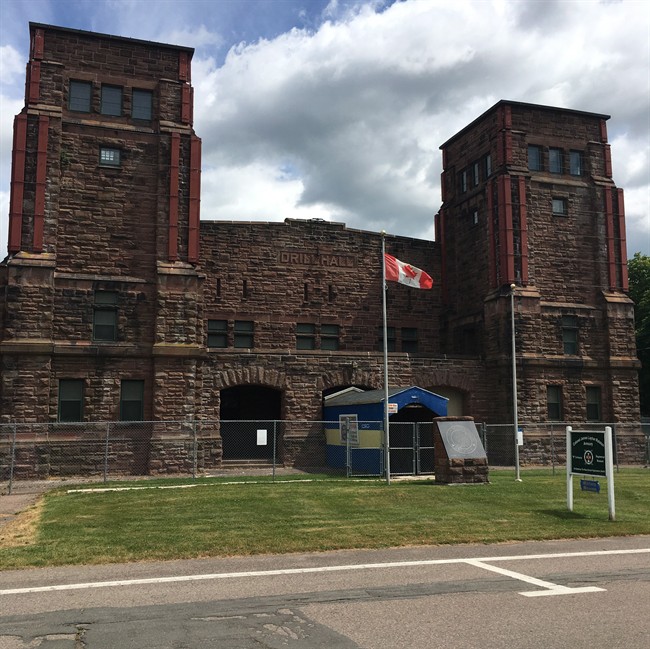The federal government is planning to sell off the historic, century-old armoury in Amherst, N.S., to make way for new housing, but the town’s mayor says that could be a bad idea.

“I’m sure there will be negative reaction,” Mayor David Kogon said in an interview Wednesday. “Who would buy this structure to tear it down and build houses? It’s unaffordable. It would be millions of dollars to demolish that building.”
In the federal budget released Tuesday, the Liberal government said it will free up lands held by the Defence Department and Canada Post to make room for the construction of housing across the country.
The goal is to build 3.87 million new homes by 2031, adding two million homes to the 1.87 million the country was already on track to build. To help accomplish that goal, the Defence Department will be working with the Canada Lands Company to divest 14 surplus properties.
“Today, governments across Canada are sitting on surplus, underused and vacant public lands, such as empty office towers or low-rise buildings that could be built on,” the budget says.
“By unlocking these lands for housing, governments can lower the costs of construction and build more homes, faster, at prices Canadians can afford …. Moving forward, the federal government will partner with the housing sector to build homes on every possible site across the federal portfolio.”
Among those sites is the Amherst Armoury in northern Nova Scotia, built in 1915 to house the 85th Canadian Infantry Battalion, which played a crucial role in the battle at Vimy Ridge during the First World War.
The huge sandstone building, a recognized federal heritage building since 1990, was declared surplus in 2016 after the local army reserve unit moved out. But it is still used for community functions, concerts, military cadet training and to house the Nova Scotia Highlanders Regimental Museum.
“We have a historical society that wants to preserve that building,” said Kogan, who stressed that he was expressing personal opinions, as he had yet to speak with town staff or other councillors. “The historical significance is very, very important to the veterans of our community and their families.”
The building, which includes a drill hall, was originally used as a military training centre during the First World War. It is also well known for its close connection to the North Nova Scotia Highlanders, who on June 6, 1944, were among thousands of Canadian soldiers sent to land on the beaches of Normandy during the D-Day invasion.
The infantry regiment landed on Juno Beach and advanced 10 kilometres inland, as did the Queen’s Own Rifles of Canada, the furthest advances of any units on D-Day. Also known as the North Novies, the regiment continued to fight in northwestern Europe until the end of the Second World War.
The local MP, Conservative Steven Ellis, said the federal government’s decision to “divest” the property could mean handing it to local groups that want to preserve the property, but federal budget documents indicate the plan is for redevelopment of the site for housing.
“I would like to see divestiture mean that it is in a position to be used and repurposed with significant consultation with the local community,” said Ellis, a former Royal Canadian Air Force member who was once the honorary colonel of the Nova Scotia Highlanders.
“It has special meaning for me …. On the 75th anniversary of D-Day, I was wearing the Highlander kilt on Juno Beach and experienced that history as well.”
Ellis said the armoury is in rough shape. “The roof is leaking and there are barrels of water that are inside the armoury itself,” he said, adding that the Amherst Armoury Plus Society has been advocating for a shift in ownership.
In Halifax, provincial Housing Minister John Lohr said the armoury has long been an important asset and public meeting space. “We would need to better understand the details before we could comment further,” he said.
The building was temporarily closed in 2020 for an engineering review, which found its huge twin towers were in poor condition and that various repairs were needed within 10 years. That closure angered local residents.
“The temporary closure was a surprise to the community; this was our mistake,” the Defence Department said at the time. “Information on the closure was not sent to everyone who uses the armoury at the same time.”
In response, the local member of the provincial legislature, Elizabeth Smith-McCrossin, staged a rally outside the armoury, where she told the crowd that it was unfair for the federal government to invest millions of dollars to repair the aging armoury in Halifax and then fail to do the same in Amherst.
“We matter,” she told the crowd. “The men and women who died from this community matter. Our youth matter. We’re going to keep on fighting.” McCrossin could not be reached for comment Wednesday.
Meanwhile, Kogon called the federal government’s plan fiscally irresponsible.
“The financial investment in demolishing that armoury to do something else with the land — it would be a whole lot easier to use other available land,” he said, adding that other territory available within town limits costs “next to nothing.”
This report by The Canadian Press was first published April 17, 2024.



Comments